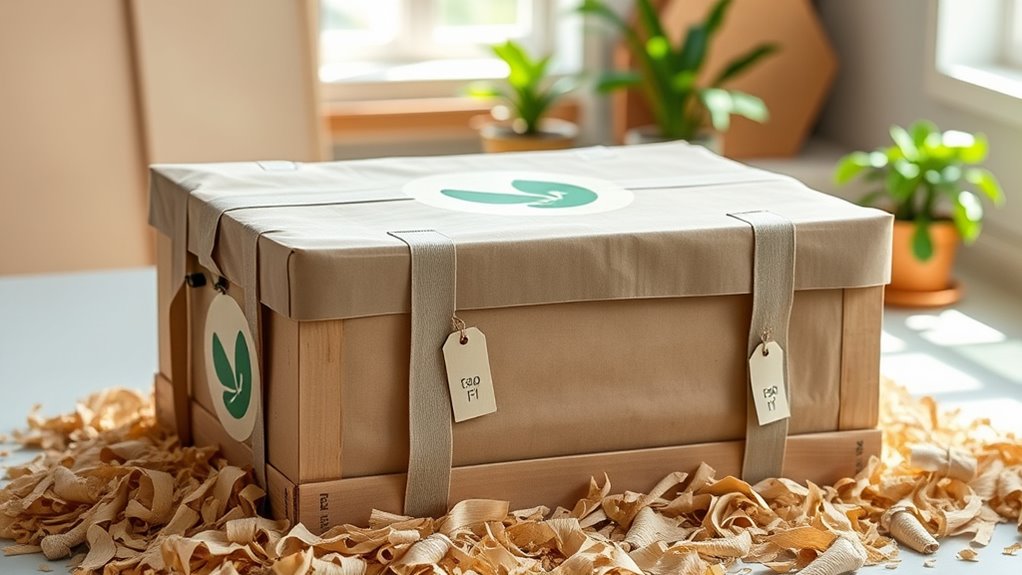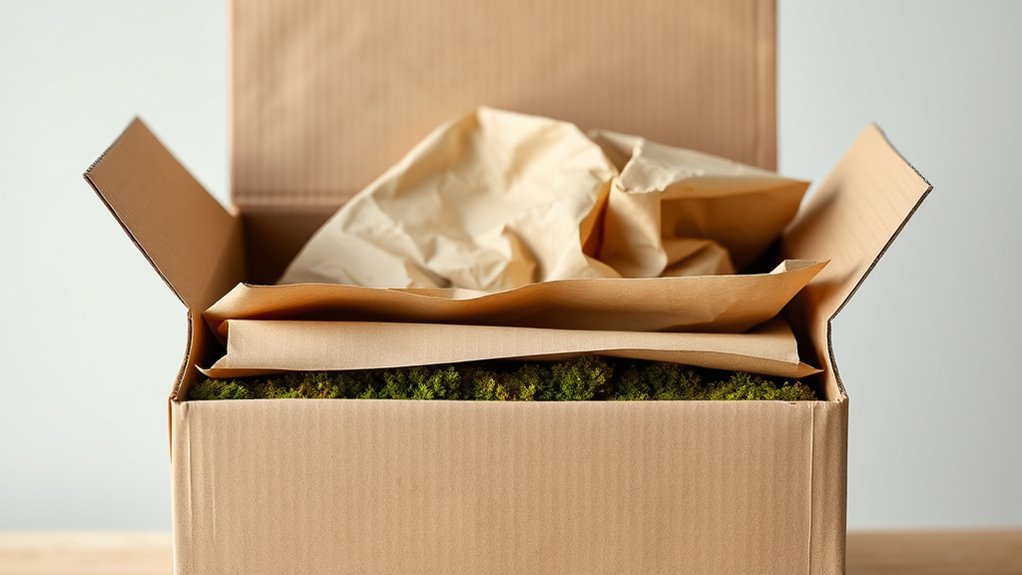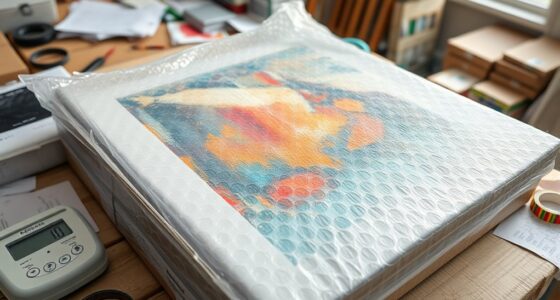To ship art sustainably, choose recycled and biodegradable packaging materials like cardboard, paper fillers, and plant-based air pillows. Use minimal, appropriately sized boxes to reduce waste and guarantee protection. Label your packaging clearly for recycling or composting and opt for eco-friendly alternatives to plastics. Incorporate eco-conscious content and design principles that support the circular economy. If you keep exploring, you’ll discover more ways to make your art shipments eco-friendly and impactful.
Key Takeaways
- Use recycled, biodegradable, or recyclable materials like cardboard, paper, and plant-based fillers to minimize environmental impact.
- Opt for minimal packaging with snug-fitting boxes and paper-based cushioning to reduce waste while ensuring artwork protection.
- Incorporate eco-friendly design elements with clear disposal labels and visual cues promoting recycling and composting.
- Select environmentally themed content, such as eco-conscious anime movies, to reinforce sustainability messaging.
- Highlight your commitment to sustainability through packaging choices, enhancing brand reputation and meeting eco-conscious customer expectations.

Sustainable packaging is gaining importance as businesses and consumers become more aware of environmental impacts. When you’re shipping artworks, this awareness translates into choosing packaging solutions that are both eco-friendly and effective. One of the key steps you can take is to prioritize recycling materials. Using recycled cardboard, paper, or foam helps reduce waste and minimizes your carbon footprint. These materials are often just as durable as their virgin counterparts, so you don’t have to compromise on protection for your valuable art pieces. By selecting packaging that incorporates recycled content, you’re actively supporting the circular economy and demonstrating your commitment to sustainability.
Prioritize recycled materials to protect artworks and support sustainability.
In addition to recycling materials, designing your packaging with eco-friendly principles in mind plays a pivotal role. Eco friendly design involves choosing materials that are biodegradable, compostable, or easily recyclable after use. For example, instead of bubble wrap, you might opt for biodegradable packing peanuts or air pillows made from recycled or plant-based plastics. These alternatives not only protect your artwork but also reduce the environmental impact once the packaging is discarded. When designing your packaging, consider minimizing waste by using appropriately sized boxes that fit your artwork snugly, avoiding excess material. This approach reduces the amount of material needed and makes recycling or composting more straightforward for your recipients.
Another aspect of eco friendly design involves the use of minimal packaging. Think about whether each layer of protection is truly necessary or if there are ways to streamline your materials without sacrificing safety. For instance, using paper-based fillers instead of plastic bubble wrap can serve as effective cushioning while being more sustainable. You should also consider the visual aspect—using packaging that clearly indicates it’s recyclable or compostable encourages recipients to dispose of it responsibly, extending the sustainability cycle. Clear labeling and instructions can guide your customers in recycling materials properly, ensuring your efforts don’t end with just the shipping process.
Furthermore, choosing anime movies that are environmentally conscious in their themes can reinforce your commitment to sustainability, as many contemporary productions promote eco-awareness and responsible storytelling. Ultimately, integrating recycling materials and eco friendly design into your art shipment process isn’t just good for the planet; it also enhances your brand image. Customers increasingly prefer to support businesses that prioritize sustainability, and your commitment to eco-conscious packaging can set you apart. By making mindful choices about the materials you use and how you design your packaging, you contribute to a healthier environment and demonstrate that protecting artworks can go hand-in-hand with protecting the planet. Every shipment becomes an opportunity to showcase your dedication to sustainability, inspiring others and fostering a more eco-conscious art community.
Frequently Asked Questions
How Does Sustainable Packaging Impact Shipping Costs?
You might wonder how sustainable packaging impacts shipping costs. It can initially seem more expensive, but with cost-saving strategies like choosing durable, lightweight materials, you reduce overall expenses. Plus, sustainable packaging minimizes environmental impact, aligning your shipping practices with eco-friendly values. Over time, these strategies can lower costs, improve your brand image, and promote responsible shipping, making sustainability a smart investment rather than a burden.
Are There Certifications for Eco-Friendly Packaging Materials?
You might be glad to know there are certifications for eco-friendly packaging materials. These include eco label programs that verify products meet strict sustainability criteria, and recycling standards that guarantee materials can be reused or properly disposed of. These certifications help you choose packaging that’s environmentally responsible, reduces waste, and supports sustainability efforts. By selecting certified eco-friendly options, you contribute to a greener future while meeting industry standards.
How Do Sustainable Options Compare in Protection Quality?
You know what they say—”you get what you pay for.” When comparing sustainable options, eco-friendly materials often match traditional packaging in protection quality, thanks to improved packaging durability. While some might worry about durability, many eco-friendly materials now offer excellent protection for art shipments. With proper design, these options can safeguard your artwork just as well, proving that sustainability and protection can go hand in hand.
What Are the Best Practices for Recycling Packaging Materials?
You should focus on effective recycling techniques and material reuse to reduce waste. Start by sorting packaging materials properly, ensuring they’re clean and dry before recycling. Look for recyclable labels and avoid contamination. Reuse sturdy boxes and packing materials whenever possible to extend their life. By adopting these practices, you help minimize environmental impact and promote sustainability, making sure packaging materials are reused efficiently and recycled correctly.
Can Sustainable Packaging Be Customized for Fragile Art?
Imagine carefully wrapping a delicate masterpiece, knowing your packaging can be both sustainable and tailored. Yes, you can customize sustainable packaging for fragile art by incorporating biodegradable options that protect without harm. Using art preservation techniques, you can design padded, eco-friendly materials that cushion and preserve your artwork while reducing environmental impact. This blend of innovation guarantees your art stays safe, aligning with your eco-conscious values.
Conclusion
By choosing sustainable packaging, you gently nurture our planet’s future, much like a tender gardener tending delicate blooms. Your mindful choices create a protective embrace around each artwork, ensuring it arrives safely while quietly reducing environmental footprints. With every thoughtful shipment, you help foster a more vibrant, resilient world—where beauty and care coexist in harmony. Embrace these eco-friendly options, and let your actions subtly paint a brighter, greener canvas for tomorrow.









